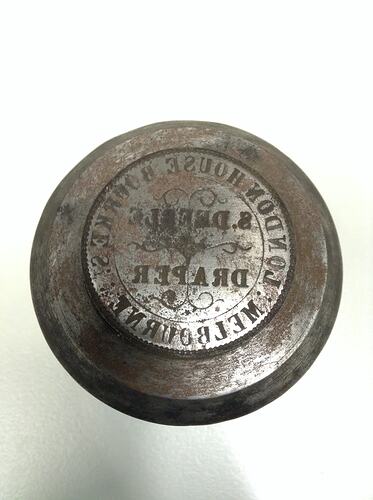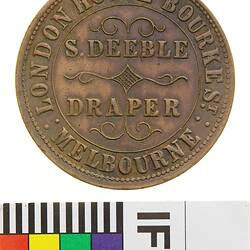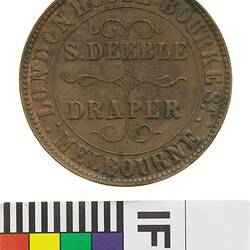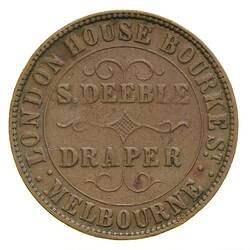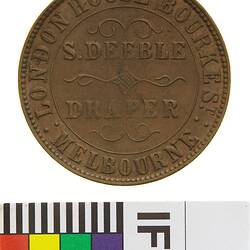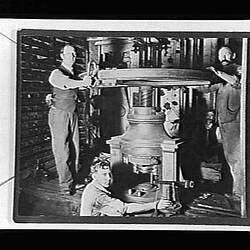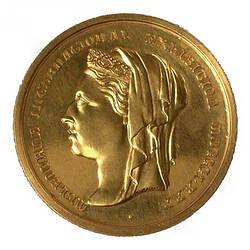Summary
Steel One Penny Token, made by Thomas Stokes, Melbourne. For S. Deeble, Draper, Melbourne, 1862. Samuel Deeble arrived in Melbourne in 1853. He opened a shop in Melbourne shortly after his arrival, in 1858 Deeble advertised in the Sands and McDougall Melbourne Directory, describing himself as a wholesale and retail draper, specalising in millinery including 'Bonnets, Hats, Bonnet Shapes, Blonds, Ribbons, Feathers &c., at wholesale prices.'
Previous Collections: Stokes
Physical Description
A steel die 55 mm high with a base diameter of 54 mm and a working surface diameter of 28 mm. The die features within plain circle superimposed above scrollwork, S.DEEBLE / DRAPER around, : LONDON HOUSE BOURKE ST. : MELBOURNE all incuse mirror It has suffered rust pitting.
Obverse Description
Within plain circle superimposed above scrollwork, S.DEEBLE / DRAPER around, : LONDON HOUSE BOURKE ST. : MELBOURNE all incuse mirror
More Information
-
Collecting Areas
-
Acquisition Information
Transfer from National Gallery of Victoria (NGV), 15 Mar 1976
-
Date Issued
1862 AD
-
Issued By
-
Mint
Stokes (Mint), Melbourne, Greater Melbourne, Victoria, Australia, 1862
-
Commissioned By
Samuel Deeble - Draper, Melbourne, Greater Melbourne, Victoria, Australia, 1862
-
Previous Collection
Harry Stokes
Harry Stokes (needs checking was it Thomas Sotkes?). -
Inscriptions
S.DEEBLE DRAPER LONDON HOUSE BOURKE ST MELBOURNE (incuse mirror)
-
Series
-
Material
Steel
-
Classification
-
Category
-
Discipline
-
Type of item
-
Dimensions
54 mm (Height), 54 mm (Outside Diameter)
-
Shape
Cylinder
-
References
S. Deeble arranged for trade tokens from Stokes in 1862, four variations resulted perhaps reflecting four different orders. On each the same obverse was employed but there were four different stock Stokes reverses. Two forms of the Arms, one with the motto ADVANCE AUSTRALIA and the other with the motto ADVANCE VICTORIA, one with the wheat sheaf and one with an emu. "An examination of the tokens suggests that V.61, with the Arms 1 reverse, was the first token type to be struck. On examples of V.61 there is no sign of clashing and the flans are thin. It would appear that Stokes then struck their own token, V.130, which has Stokes legend obverse and Sheaf 1 reverse, during that work the dies clashed. Then the Deeble obverse was reloaded with the Sheaf 1 left in place. This produced V.62 which had thin blanks and evidence of the recent die clash with the Stokes obverse on well preserved examples. The next isssue appears to have been V.63. During the production of these tokens with the Arms 5 reverse, the dies also clashed and Deeble's own die was slightly damaged (the number 86 from the reverse die's date being transferred). The clashing is visable on tokens from the final striking V.64. The forms V.63 and V.64 are both recorded with thin and thick flans and with two opposing settings of the die axis suggesting two settings of these die forms in the press at different times. Finally the Deeble obverse die may have been employed in the Twentieth century to produce a concoction with Emu 2. The Andrews manuscript includes a rubbing from this die combination but it has not been confirmed." J. Sharples NAA 7 p.34 For V.61 see NU 11132 for V.62 see NU 3687 for V.63 see NU 11134 for V.64 NU 3689 for the obverse die see NU 35778 This token "is one of the thin series of tokens issued by Stokes before he procured his rolling machine when he had to use any copper that was on the market, later he rolled his own copper of uniform thickness" Alfred Chitty collection catalogue 1923 p. 75.
[Book] Andrews, Arthur. 1921. Australasian Tokens and Coins.
[Article] Sharples, John P. 1993. A Catalogue of the Trade Tokens of Victoria 1848 to 1862. Journal of the Numismatic Association of Australia. vol.7: p.1-77.
-
Keywords
